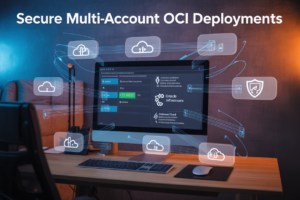Zero Trust Simplified: Why OIDC Is the Key to Modern Security
Traditional security models that trust everything inside the network perimeter are dead. Cybersecurity leaders, IT architects, and enterprise security teams now face a reality where data breaches happen from both outside attackers and insider threats. The zero trust security model changes this game completely—every user and device must prove their identity before accessing any resource, regardless of location.
OpenID Connect (OIDC) sits at the heart of this transformation. While zero trust architecture sounds complex, OIDC authentication makes it practical and manageable for real organizations. This modern identity management approach gives you the tools to build identity-based security that actually works in today’s distributed work environment.
We’ll break down how the zero trust framework operates and why identity verification drives everything. You’ll discover how OIDC zero trust integration creates a seamless authentication experience while maintaining rock-solid security. Finally, we’ll walk through proven implementation strategies that help you avoid common pitfalls and deliver measurable security improvements to your organization.
Understanding Zero Trust Architecture Fundamentals
Breaking Down Traditional Perimeter-Based Security Models
Traditional security models built fortress-like defenses around network perimeters, assuming everything inside was trustworthy. This castle-and-moat approach relied heavily on firewalls, VPNs, and network segmentation to keep threats out. Once attackers breached the perimeter, they could move laterally through systems with minimal resistance. The rise of remote work, cloud computing, and mobile devices shattered these assumptions, exposing critical vulnerabilities. Modern threats often originate from within trusted networks, making perimeter-based security insufficient for today’s distributed enterprise environments.
Core Principles of Never Trust, Always Verify
Zero trust architecture operates on the fundamental principle that no user, device, or network should be trusted by default, regardless of location. Every access request requires explicit verification through multiple authentication factors before granting permissions. The zero trust security model enforces continuous monitoring and validation of all interactions, treating internal networks as potentially hostile environments. Access controls depend on user identity, device health, location context, and behavioral patterns rather than network position. This approach creates granular security policies that adapt dynamically to changing threat landscapes.
How Zero Trust Eliminates Implicit Trust Assumptions
Zero trust frameworks systematically remove assumptions about network trustworthiness by implementing identity-based security controls at every interaction point. Instead of granting broad network access, the zero trust authentication protocols verify specific resource requests individually. Each connection requires fresh validation, preventing attackers from exploiting previously established trust relationships. Modern identity management systems become the cornerstone of this approach, ensuring that access decisions rely on verified user credentials rather than network location. This elimination of implicit trust transforms security from a perimeter-focused strategy into a comprehensive, identity-driven defense system.
The Critical Role of Identity in Zero Trust Implementation
Why Identity Becomes Your New Security Perimeter
Traditional security models relied on castle-and-moat defenses, assuming everyone inside the network was trustworthy. Zero trust architecture flips this concept by making identity the primary security boundary. Every user, device, and application must prove their legitimacy before accessing resources, regardless of their location. This identity-based security approach treats the user’s verified identity as the new perimeter, moving away from implicit trust based on network location. Organizations implementing zero trust security model recognize that identity verification becomes the cornerstone of their entire defense strategy.
Moving Beyond Network-Based Access Controls
Legacy network security depended on firewalls and VPNs to create secure zones, but modern threats easily bypass these static defenses. Zero trust framework eliminates the concept of trusted networks entirely, forcing every access request through rigorous identity verification. Instead of granting broad network access, organizations now evaluate each connection attempt individually. OIDC authentication protocols enable this granular approach by providing standardized identity verification that works across diverse applications and services. This shift represents a fundamental change from protecting networks to protecting individual resources through verified identities.
Creating Comprehensive User and Device Verification Systems
Modern identity management requires verification of both human users and their devices before granting access. Zero trust authentication protocols demand multiple verification factors, including device health, user behavior patterns, and contextual information like location and time. OpenID Connect implementation supports this multi-layered approach by standardizing how applications receive and validate identity information. Organizations build comprehensive verification systems that continuously assess risk factors, from device compliance status to user authentication methods. This holistic approach creates a robust foundation where every access decision considers the complete identity picture.
Establishing Continuous Authentication Protocols
Static authentication methods that verify identity once at login are insufficient for modern security needs. Enterprise security architecture now requires continuous validation throughout user sessions, adapting access rights based on changing risk levels. OIDC zero trust integration enables this dynamic authentication by providing real-time identity verification capabilities. Systems monitor user behavior, device status, and access patterns to detect anomalies and adjust permissions accordingly. This continuous assessment creates a living security posture that responds to threats in real-time, maintaining the principle that trust must be continuously verified rather than assumed.
OIDC as the Foundation for Modern Identity Management
Decoding OpenID Connect Protocol Benefits
OpenID Connect transforms modern identity management by combining OAuth 2.0’s authorization framework with standardized authentication layers. This protocol delivers secure, token-based identity verification while maintaining interoperability across diverse platforms. OIDC authentication provides cryptographically signed identity tokens that contain verified user attributes, enabling organizations to establish trusted digital identities without storing sensitive credentials locally. The protocol’s stateless architecture reduces server overhead while supporting scalable enterprise deployments.
Seamless Single Sign-On Across Multiple Applications
OIDC enables users to authenticate once and access multiple applications without repeated login prompts. The protocol’s token-based approach allows identity providers to issue JSON Web Tokens containing user identity claims that applications can trust and validate independently. This creates a frictionless user experience where employees can move between cloud services, internal applications, and third-party tools using their verified organizational identity. The standardized token format ensures consistent authentication behavior across heterogeneous application environments.
Standardized Token-Based Authentication Mechanisms
OpenID Connect implementation leverages industry-standard JSON Web Tokens (JWT) that carry digitally signed identity information. These tokens contain structured claims about user identity, authentication methods, and session parameters that applications can decode and verify independently. The protocol defines specific token types including ID tokens for authentication and access tokens for authorization, creating clear separation between identity verification and resource access. This standardization enables seamless integration with zero trust security models that require continuous identity validation.
Enhanced User Experience Without Compromising Security
OIDC balances security requirements with user convenience through intelligent session management and adaptive authentication flows. The protocol supports step-up authentication where users can access low-risk resources with basic credentials while sensitive operations trigger additional verification steps. Modern identity management benefits from OIDC’s ability to maintain secure sessions across devices while providing transparent access to authorized resources. Users experience reduced password fatigue while organizations maintain strong identity assurance through cryptographic token validation.
Integration Capabilities with Existing Infrastructure
OpenID Connect integrates smoothly with existing directory services, legacy applications, and modern cloud platforms through standardized API endpoints and well-defined integration patterns. Organizations can connect OIDC providers to Active Directory, LDAP systems, and cloud identity services without extensive infrastructure changes. The protocol’s vendor-neutral approach ensures compatibility with major identity providers while supporting custom implementations. This flexibility allows gradual migration to zero trust architecture without disrupting existing user workflows or requiring complete system overhauls.
Implementing OIDC Within Zero Trust Frameworks
Connecting Identity Providers to Resource Servers
Setting up the bridge between identity providers and resource servers forms the backbone of OIDC zero trust integration. Your identity provider acts as the central authentication hub, validating user credentials and issuing tokens that resource servers can trust. Configure your OIDC provider to establish secure communication channels using HTTPS endpoints and properly formatted discovery documents. Resource servers must register with the identity provider, receiving unique client credentials that enable them to verify incoming tokens. This connection creates a trust relationship where servers can authenticate users without directly handling credentials, reducing security risks while maintaining seamless access control across your zero trust architecture.
Establishing Secure Authorization Flows
Authorization flows in OIDC zero trust implementation require careful selection based on your application architecture and security requirements. The Authorization Code flow with PKCE provides the strongest security for web applications, preventing token interception through secure code exchange mechanisms. Single-page applications benefit from the Implicit flow, though the Authorization Code flow with PKCE is increasingly preferred for enhanced security. Machine-to-machine communication works best with Client Credentials flow, enabling automated systems to authenticate without user intervention. Each flow must incorporate proper redirect URI validation, state parameters for CSRF protection, and nonce values to prevent replay attacks, creating multiple security layers that align with zero trust principles.
Managing Token Lifecycle and Refresh Mechanisms
Token management becomes critical when implementing OIDC authentication within zero trust frameworks, balancing security with user experience. Access tokens should have short lifespans (15-60 minutes) to limit exposure if compromised, while refresh tokens enable seamless session continuation without repeated authentication. Implement proper token storage using secure mechanisms like httpOnly cookies or encrypted browser storage. Your system needs automated refresh logic that handles token renewal before expiration, maintaining continuous authentication state. Monitor token usage patterns to detect anomalies, and implement proper revocation mechanisms for compromised tokens. This lifecycle management ensures that your modern identity management system maintains security while providing smooth user experiences across your enterprise security architecture.
Real-World Security Benefits of OIDC-Powered Zero Trust
Reducing Attack Surface Through Precise Access Controls
OIDC authentication within zero trust architecture dramatically shrinks potential entry points for cyber threats by enforcing strict identity verification before granting any network access. Traditional perimeter-based security models create broad attack surfaces where compromised credentials can provide extensive system access. Modern identity management through OIDC tokens ensures each authentication request undergoes rigorous verification, creating multiple checkpoints that attackers must overcome. This layered approach means even sophisticated threat actors face significant barriers when attempting unauthorized access. The zero trust security model paired with OpenID Connect implementation creates granular access boundaries that adapt dynamically based on user context, device status, and behavioral patterns, making it exponentially harder for malicious actors to exploit system vulnerabilities.
Preventing Lateral Movement in Compromised Networks
When attackers breach initial defenses, OIDC-powered zero trust frameworks prevent the devastating lateral movement that typically follows network compromises. Each service interaction requires fresh token validation, creating natural barriers that contain potential breaches within specific network segments. Traditional security architectures often fail because once inside, attackers move freely between systems using stolen credentials. Zero trust authentication protocols demand continuous identity verification, meaning compromised accounts cannot automatically access additional resources without triggering security alerts. This containment strategy transforms what could be catastrophic enterprise-wide breaches into isolated incidents with limited impact. The identity-based security approach ensures that even successful initial attacks remain confined to their original entry point, buying security teams valuable time to detect and respond.
Enabling Granular Permission Management
OIDC zero trust integration delivers unprecedented precision in access control through dynamic, context-aware permission assignments that adapt to real-time security conditions. Unlike static role-based systems, this approach evaluates multiple factors including user location, device trust level, time of access, and behavioral patterns before granting specific permissions. Enterprise security architecture benefits from this flexibility as permissions can be instantly modified or revoked without affecting other user privileges. The system automatically adjusts access levels based on risk assessments, ensuring sensitive resources remain protected while maintaining operational efficiency. This granular control extends to API access, file sharing, and application permissions, creating a comprehensive security framework that scales with organizational complexity while maintaining strict oversight of every access decision.
Improving Compliance and Audit Capabilities
Zero trust framework implementation with OIDC creates comprehensive audit trails that satisfy even the most stringent regulatory requirements while simplifying compliance reporting processes. Every authentication attempt, access request, and permission change generates detailed logs that provide complete visibility into user activities across the entire network infrastructure. This transparency proves invaluable during compliance audits, as organizations can demonstrate precise control over data access and user permissions. The immutable token-based system ensures audit logs maintain integrity and cannot be manipulated by bad actors seeking to cover their tracks. Automated compliance reporting becomes possible as the system continuously monitors access patterns against established policies, flagging potential violations before they escalate into regulatory issues that could result in significant financial penalties.
Overcoming Common Implementation Challenges
Addressing Legacy System Integration Complexities
Legacy systems pose significant challenges when implementing OIDC authentication within zero trust frameworks. Organizations often struggle with applications that lack modern API capabilities or rely on outdated authentication methods. The solution involves deploying identity proxies and API gateways that can translate between legacy protocols and modern OIDC standards. Companies should establish hybrid architectures where legacy systems gradually integrate with OIDC providers through middleware solutions. This approach allows for incremental migration while maintaining operational continuity. Identity bridges can handle protocol translation, enabling older applications to participate in zero trust security models without complete system overhauls. Planning should include detailed mapping of legacy dependencies and establishing clear timelines for modernization efforts.
Managing User Adoption and Change Resistance
User resistance represents one of the biggest hurdles in zero trust authentication protocols deployment. Employees often view additional security measures as productivity obstacles, especially when transitioning from simple password-based systems to multi-factor OIDC authentication. Success depends on comprehensive training programs that demonstrate security benefits without overwhelming users with technical complexity. Organizations should implement gradual rollouts, starting with power users who can become internal advocates. Clear communication about why changes are necessary helps build buy-in. User experience design becomes critical – seamless single sign-on experiences through OIDC can actually improve productivity by reducing password fatigue. Regular feedback collection and rapid resolution of user concerns prevents adoption failures. Change management strategies should emphasize security improvements while highlighting convenience benefits of modern identity management systems.
Balancing Security Requirements with Operational Efficiency
Zero trust architecture implementation often creates tension between robust security controls and operational efficiency. Organizations must carefully calibrate authentication frequency, risk-based access policies, and user experience expectations. OIDC zero trust integration should leverage adaptive authentication that adjusts security requirements based on user behavior, device trust, and network location. Smart policy engines can reduce friction for low-risk activities while maintaining strict controls for sensitive operations. Performance optimization becomes essential – authentication workflows must complete quickly to avoid productivity impacts. Token lifecycle management through OpenID Connect implementation allows for granular control over session lengths and re-authentication triggers. Companies should establish metrics that measure both security effectiveness and operational impact, creating feedback loops for continuous policy refinement. The goal is creating enterprise security architecture that strengthens protection while enabling business agility.
Zero Trust security isn’t just another tech buzzword – it’s become the backbone of how smart organizations protect themselves today. By putting identity at the center of everything and never assuming anyone or anything can be trusted by default, companies are finally getting ahead of cyber threats instead of just reacting to them. OIDC makes this whole approach actually workable by giving you a solid, standardized way to handle authentication and authorization across all your systems and apps.
The best part about combining OIDC with Zero Trust is that you don’t have to rip out everything you’ve already built. You can start small, tackle the biggest security gaps first, and gradually expand your implementation as you get comfortable with the technology. Sure, there are some bumps along the way – like getting your team up to speed and working through integration hiccups – but the payoff in terms of better security and easier management makes it all worthwhile. If you’re still sitting on the fence about modernizing your security approach, now’s the time to start planning your Zero Trust journey with OIDC as your guide.




















